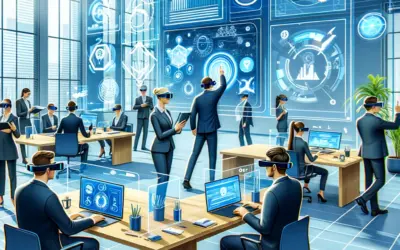1. The Latest Innovations in Metaverse Remote Work Tools
Enhanced Virtual Spaces for Team Collaboration
Contemporary Metaverse platforms have introduced sophisticated virtual offices that enable teams to work together as if they were in the same physical space. These tools deliver a three-dimensional experience complete with office layouts that include meeting rooms, private pods, and communal social areas. A key advancement is the integration of AI to personalize workspaces and adapt them dynamically based on team needs and workflow requirements, thus enhancing productivity and collaboration.
Real-Time Avatars and AI-Driven Interactions
The introduction of real-time avatars has revolutionized the way individuals represent themselves in the Metaverse. Innovations in this space allow for avatars that mimic human expressions and gestures, leading to more nuanced communication. Artificial Intelligence enhancements facilitate interactions with virtual assistants capable of performing tasks ranging from scheduling to resource allocation, creating a seamless remote working experience.
Immersive Learning and Development Tools
Continuous learning and professional development are pillars of a thriving remote workforce. The Metaverse now boasts immersive learning environments where employees can engage in hands-on training through simulations that mirror real-world scenarios. These tools are not just about replicating a physical classroom but about enriching the learning experience with interactivity and gamification techniques, enabling employees to learn and retain information more effectively.
Interoperable Platforms and Seamless Integration
In pursuit of a fully interconnected Metaverse, developers are focusing on interoperability between different platforms and systems. The goal is to enable users to transport assets, maintain consistent avatars, and utilize various tools across multiple virtual spaces without friction. This interconnectivity ensures that remote teams can work together efficiently, regardless of individual platform preference or the specific tools they require. Another significant innovation is the improved integration with traditional productivity suites, ensuring that users can shift between virtual and regular work environments effortlessly.
2. Maximizing Productivity with Metaverse Collaboration Platforms
Embracing the Future of Teamwork
The traditional workspace is undergoing a transformative shift with the advent of metaverse collaboration platforms. These groundbreaking virtual environments are redefining how teams communicate, interact, and achieve objectives. With the integration of 3D spaces, immersive interactions, and real-time collaboration tools, professionals are discovering new levels of efficiency and engagement.
These platforms facilitate a seamless blend of digital and physical realities, fostering a sense of presence that transcends geographical boundaries. By leveraging avatars and virtual representations, team members can experience a shared virtual workspace that is both interactive and productive. The metaverse’s capacity to support collaborative projects, brainstorming sessions, and virtual meetings is enhancing collective creative processes and multifaceted problem-solving.
Key Features of Metaverse Collaboration Tools
- Customizable Environments: Enrich your team’s creative landscape by tailoring virtual spaces to fit the project or organizational culture, setting the stage for innovative workflows.
- Interactive Tools: Utilize sophisticated tools, such as virtual whiteboards and 3D models, to brainstorm and visualize concepts in ways that traditional settings cannot accommodate.
- Immersive Communication: Engage in lifelike conversations with spatial audio and gestures, making remote communication as natural and nuanced as in-person interactions.
Companies are leveraging these immersive features to create an optimized work environment, free from the constraints of physical office setups. Productivity is heightened as team members can effortlessly populate their virtual workspace with dynamic resources and instantly connect with colleagues worldwide.
Advantages of Metaverse Collaboration for Teams
- Global Accessibility: The metaverse dissolves physical distances, allowing instant collaboration across time zones and locations, thus widening the talent pool and fostering diversity.
- Enhanced Engagement: Virtual collaboration platforms combat the monotony of video calls and static documents, injecting an element of gamification that promotes active participation and retention.
- Scalable Solutions: Adapt to the size and scope of any project, scaling the virtual environment as necessary without the need for physical resources, thereby reducing overhead costs.
By tapping into the extensive possibilities of metaverse collaboration platforms, organizations can significantly increase productivity and create a more engaging workplace culture. The metaverse simplifies complex tasks through its intuitive design, making it easier for teams to navigate workflows and manage projects efficiently. This innovative approach to collaboration promises to revolutionize productivity strategies and establish new benchmarks for interactive teamwork.
3. Building Remote Teams in the Metaverse: A Guide to Effective Management
As the dawn of the metaverse reshapes our concept of workspace, leaders are required to adapt to the dynamic, immersive virtual environments. Building remote teams in the metaverse isn’t simply about replicating the physical office in a digital space; it’s about leveraging the very essence of this platform for enhanced collaboration, creativity, and productivity. In this transformative era, successful management requires understanding the unique aspects of the metaverse and its potential impact on team dynamics.
Establishing a Robust Virtual Infrastructure
The foundation for any effective remote team is the infrastructure that supports it. In the context of the metaverse, this extends to the selection of virtual platforms, integration of communication tools, and the setup of virtual spaces that serve as offices or meeting rooms. To begin, choose a metaverse platform that caters to your industry’s specific needs and allows for seamless interactions among team members. Adequate onboarding processes that familiarize team members with navigation and tools in the metaverse is not just helpful but essential. A comprehensive digital onboarding can ease the transition and boost team competence.
Fostering an Inclusive and Motivated Team Culture
The metaverse breaks down geographical barriers, bringing together individuals from diverse backgrounds into one virtual space. While this promises rich diversity, it also presents challenges. An effective approach is to instill a sense of belonging and purpose within the team, promoting an environment where every member feels valued and motivated. Regular virtual meetups, fun team-building exercises, and appreciation events can help in crafting a vibrant community that is connected beyond work tasks. Moreover, setting clear goals and rewarding achievements strengthens team spirit and drives performance.
Implementing Effective Communication and Collaboration Practices
Communicating in the metaverse bears the advantage of richer, more nuanced interactions than traditional remote setups. However, this does not come without its share of challenges. Leaders must therefore establish robust communication protocols and promote the use of collaborative tools like shared virtual whiteboards or real-time document editing. Open communication channels for both one-on-one and team conversations are critical. Balancing synchronous and asynchronous communication alleviates potential digital fatigue and boosts productivity. With the right practices, remote teams in the metaverse can operate with exceptional effectiveness, with individuals contributing their best while feeling closely connected despite the physical distance.
Building and managing remote teams in the metaverse is a pioneering journey into the future of work. Yet, with careful execution and a thorough understanding of virtual environments and human factors, leaders can craft highly efficient, collaborative, and satisfied teams. In this digital era, those who embrace and master these virtual frontiers stand to reap unprecedented benefits in team cohesion and performance.
4. Integrating Metaverse Tools with Traditional Remote Work Applications
The landscape of remote work is rapidly evolving, with cutting-edge Metaverse tools stepping into a realm once dominated by more conventional applications like video conferencing and project management software. As businesses strive to create more engaging and productive virtual workspaces, integrating Metaverse tools with these traditional applications is not just fanciful but a strategic imperative for forward-thinking organizations.
Seamless Collaboration in Virtual Spaces
In the pursuit of a highly collaborative environment, traditional remote work apps are being augmented by Metaverse platforms to simulate a physical office experience. This amalgamation facilitates real-time interactions and sustains the nuances of face-to-face teamwork, all within the comfort of one’s home. With avatars representing team members in a 3D space, brainstorming sessions and team meetings can transcend the limitations of screen sharing and static presentations. Through shared virtual environments, employees can interact with digital objects and participate in immersive workshops, fostering a sense of belonging and improving collective creativity.
Enhanced Training and Onboarding
The integration of the Metaverse with conventional remote work applications has the potential to revolutionize employee training and onboarding processes. Newcomers can be introduced to a company’s culture and operations through interactive simulations that are both engaging and illustrative of real-world scenarios. This synergy between Metaverse tools and traditional training modules makes learning more intuitive and retains the personal touch that can sometimes be lost in virtual setups.
The potential of integrating Metaverse technology seamlessly with traditional remote work applications has just begun to be tapped. As this innovative convergence continues to develop, it promises to deliver not only enhanced collaboration and training but also a richer, more human remote working experience. With each step forward, businesses that adopt these integrative strategies stand to gain in terms of employee engagement, productivity, and overall company cohesion, securing a competitive edge in the evolving digital workspace.
5. Essential Security Practices for Metaverse Remote Work Platforms
5 Essential Security Practices for Metaverse Remote Work Platforms
Implement Strong Authentication Measures
In the vast and ever-expanding realms of the Metaverse, securing access points is critical. The foundation of protecting these digital spaces begins with strong authentication measures. Methods like two-factor authentication (2FA) and complex, regularly updated passwords are the starting blocks for a robust security system. For Metaverse work platforms, combining something the user knows, like a password, with something the user possesses, such as a mobile device or a hardware token, can significantly reduce the risk of unauthorized access.
Ensure End-to-End Data Encryption
In any online interaction, but especially in the Metaverse, the risk of data interception or leakage is non-negligible. To protect sensitive work-related information, end-to-end encryption is a must. It ensures that data, whether it’s a conversation, file transfer, or a collaborative project, remains unreadable to anyone other than the intended recipient. It’s crucial to choose platforms that prioritize encryption and to educate remote workers on its importance for maintaining client confidentiality and intellectual property rights.
Maintain Regular Software Updates and Patches
Vulnerabilities in software are the open doors through which cyber attackers love to enter. Keeping software up-to-date is like making sure those doors are fortified. Regular updates and patches issued by developers are pivotal in protecting Metaverse platforms. They often contain remedies for security flaws that could otherwise be exploited by malicious entities. An essential practice for businesses is to enable automatic updates when available and to frequently check for manual updates to ensure all security gaps are addressed promptly.
Maximize Privacy Settings and Controls
The Metaverse is, by design, a space where sharing is constant. However, not everything needs to be shared, especially when it comes to professional environments. Companies must train their employees to understand and properly adjust their privacy settings. By controlling who can view, interact with, or receive information from their avatar, employees can significantly minimize the risk of data exposure and leakage. Clear guidelines on privacy settings will help employees safeguard both their personal and professional personas within the Metaverse.
Provide Continuous Security Awareness Training
Even with the best technical measures in place, the human factor remains the most unpredictable part of cybersecurity. Continuous security awareness training is the key to ensuring that employees are aware of the potential risks and know how to respond to them. Workshops, simulations, and regular briefings can keep security at the forefront of every remote worker’s mind. By fostering a culture of security, employees become proactive guardians of their digital work environment.













0 comentarios